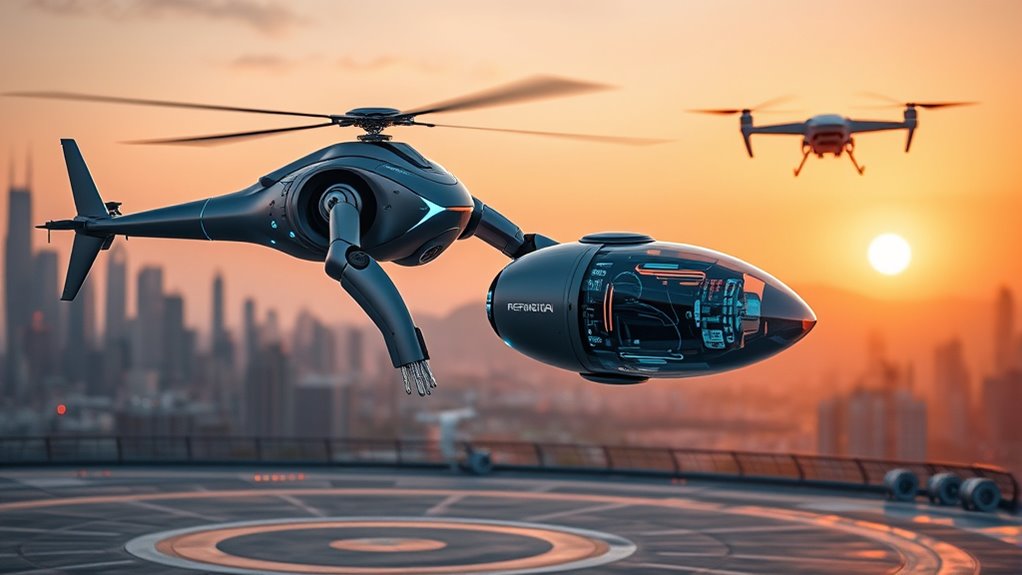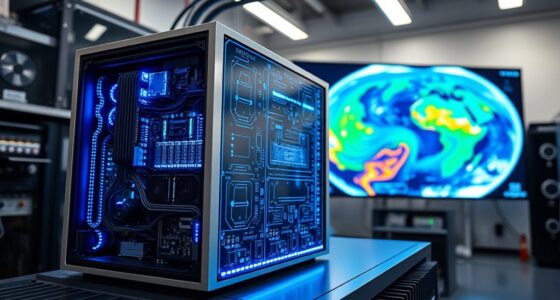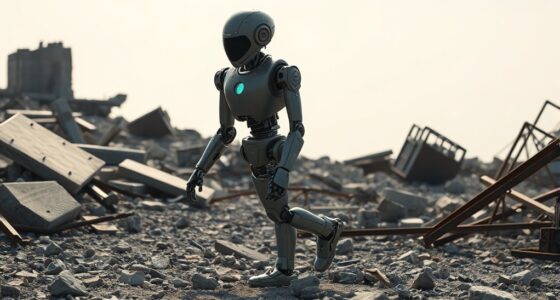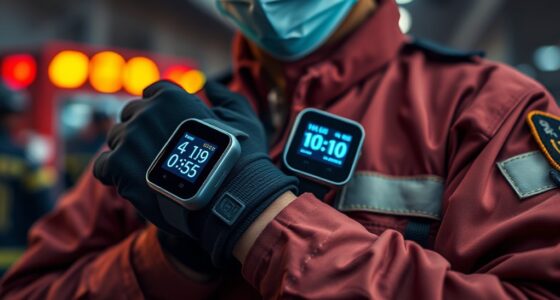AI robots are transforming medical evacuation by enabling faster, safer responses through real-time route optimization, autonomous transport, and advanced diagnostics. They reduce response times, improve coordination, and handle routine tasks, freeing up human responders for complex care. Innovations like surgical and delivery robots enhance treatment precision, while overcoming barriers like cost and regulation is key. Discover how these breakthroughs are shaping the future of emergency care and what’s next for AI in medevac services.
Key Takeaways
- AI robots will enhance emergency response efficiency through optimized routing, real-time data analysis, and resource allocation.
- Integration of AI-powered healthcare robots can streamline hospital logistics and support complex medical procedures remotely.
- Autonomous AI emergency vehicles and robots will reduce response times and improve coordination during mass casualty events.
- Community engagement and transparent policies are vital for public trust and successful AI robot adoption in medical evacuations.
- Continuous technological advancements will focus on reliability, high performance, and seamless human-robot collaboration to shape future medevac systems.
The Evolving Role of AI in Medevac Operations

AI is transforming medevac operations by making responses faster, safer, and more efficient. You benefit from intelligent dispatch systems that analyze emergency calls in real-time, quickly evaluating severity and recommending the fastest response.
AI also optimizes resource allocation by integrating with emergency networks and hospital databases, ensuring crews and aircraft are mobilized swiftly. During transport, AI enhances situational awareness by combining diverse information streams, allowing for better decision-making.
It analyzes real-time weather, air traffic, and terrain data to determine ideal flight paths and adjusts routes mid-flight to avoid hazards. Predictive analytics forecast future demands and help pre-position resources, reducing response times and costs.
Types of AI-Enabled Robots Transforming Healthcare

Different types of AI-enabled robots are revolutionizing healthcare by performing a wide range of tasks that enhance patient care and operational efficiency. AI nurse robots handle routine nursing duties, easing staff shortages and reducing burnout. Moxi robots assist with non-patient-facing tasks like delivering medication and restocking supplies, streamlining hospital workflows.
Diagnostic robots leverage AI to analyze data, improving accuracy in medical diagnoses, while clinical robots conduct genetic testing and data collection. Telepresence robots enable remote consultations and patient monitoring, expanding access to care. These advances are supported by innovations in robotic technology, which improve the precision and reliability of healthcare robots. Incorporating expert voice actors in training videos and demonstrations can further enhance understanding and adoption of these advanced systems.
Surgical robots, such as the Da Vinci system, offer precision and minimally invasive procedures, decreasing recovery times. Rehabilitation and assistive robots support mobility, monitor vitals, and help patients regain independence. Hydrocolloid technology in some AI-powered wound care robots promotes faster healing and infection control, demonstrating the integration of innovative materials in robotic healthcare solutions. Additionally, autonomous mobile robots are increasingly used to transport supplies and assist with logistics within healthcare facilities, enhancing overall efficiency.
Autonomous mobile robots and telepresence units further improve hospital logistics and patient engagement. Remote Hackathons can serve as innovative platforms for developing and testing new AI healthcare solutions, fostering collaboration among tech and medical professionals.
Advantages of Artificial Intelligence in Emergency Transports

The integration of artificial intelligence into emergency transportation markedly improves response times and operational efficiency. You benefit from optimized routes and schedules, which cut down delays and ensure faster arrival. AI analyzes real-time traffic data, guiding vehicles along the quickest paths during emergencies.
It predicts when vehicles need maintenance, minimizing breakdowns and downtime. During mass casualty events, AI helps allocate resources effectively, ensuring critical needs are met promptly. The use of cybersecurity measures in AI systems is vital to protect sensitive data and prevent malicious attacks that could compromise mission-critical operations. Implementing data security protocols is essential to safeguard patient and operational information within these systems.
Communication systems powered by AI enhance coordination among emergency teams, reducing miscommunications. Additionally, AI supports critical decision-making by providing relevant data, analyzing patient information swiftly, and maintaining situational awareness. Given the vulnerabilities in AI systems, ongoing monitoring and safety measures are essential to maintain trust and effectiveness in these critical applications. Furthermore, AI-driven diagnostics can assist in rapid assessment and treatment decisions, further improving patient outcomes.
A focus on system reliability is necessary to ensure consistent performance during high-pressure situations. These advantages collectively lead to safer, more reliable transports, ultimately saving lives and streamlining emergency medical responses.
Cutting-Edge Technological Breakthroughs in Medical Robotics

Recent advancements in medical robotics are transforming surgical practices by enabling highly precise and minimally invasive procedures. Robotic-assisted systems like the da Vinci improve accuracy and efficiency, reducing complication rates, pain, and recovery times. These systems also contribute to emotional support by providing patients with reassurance through improved outcomes and less invasive options. The market is expected to surpass $14 billion by 2026, driven by innovations such as miniaturization and micro-robotics, which further decrease invasiveness. These breakthroughs allow for complex surgeries like coronary artery bypass grafting and mitral valve repair with enhanced precision. New techniques aim to improve patient outcomes and expand access to specialized care, even in remote areas. Integrating artificial intelligence with robotics enhances personalized treatments and telesurgery possibilities. Additionally, the development of airless paint sprayers demonstrates how high-pressure, versatile tools are revolutionizing various industries, paralleling the transformative impact of medical robotics. Understanding business hours of key retailers can facilitate access to supplies and services crucial for healthcare and industry applications. Staying informed about medical robotics advances can help healthcare providers adopt new technologies more effectively. As these technologies evolve, they promise to revolutionize surgical procedures and expand the scope of minimally invasive interventions worldwide. Staying informed about retail hours can help healthcare providers and technicians efficiently access necessary supplies and support services.
Overcoming Barriers to AI Robot Adoption in Emergency Services
Advancing medical robotics in emergency services faces significant hurdles that can slow down widespread adoption. The high costs of AI robots make it challenging for many organizations to justify the investment.
Without clear regulations or standards, deploying these technologies raises legal and safety concerns. Public acceptance is another obstacle; staff and communities may resist unfamiliar AI systems due to distrust or lack of understanding. Incorporating effective sound design techniques can enhance user interfaces and training simulations for these robots, improving safety and usability.
Overcoming these barriers requires developing advanced navigation systems, establishing transparent policies, improving public education, and fostering collaborations with regulators and private partners. Understanding the hours of operation of local stores can also help in planning the deployment of emergency response units effectively. Additionally, integrating insights from Hyundai Tuning can inspire innovations that optimize the performance and reliability of emergency robotic systems. Staying informed about predictive analytics can further assist in anticipating emergency needs and improving response times. Leveraging public perceptions is crucial for building trust and acceptance among users and communities, which is vital for successful integration. Addressing these challenges is vital for integrating AI robots into emergency medical responses efficiently.
Frequently Asked Questions
How Secure Are AI Systems in Handling Sensitive Patient Data During Medevac?
You might wonder how secure AI systems are with sensitive patient data. They employ strong encryption, secure transmission protocols, and strict access controls to protect information.
Regular security audits, data anonymization, and compliance with regulations like HIPAA and GDPR further bolster security.
Continuous monitoring and updates help identify and fix vulnerabilities, ensuring the data remains confidential and protected throughout the medevac process.
What Training Is Needed for Personnel to Operate Ai-Powered Medical Robots Effectively?
Imagine you’re operating an AI-powered medical robot during a critical evacuation; proper training is essential. You’ll need a solid understanding of robotics, AI principles, and medical protocols.
Hands-on experience with simulations helps you troubleshoot and collaborate with healthcare teams. Continuous learning keeps your skills sharp as technology evolves.
This training guarantees you can interpret AI recommendations accurately, maintain safety standards, and respond effectively in emergencies.
How Do AI Robots Adapt to Unpredictable Emergency Environments in Real-Time?
You see, in unpredictable emergencies, AI robots adapt through real-time sensor data processing, dynamic navigation, and environment recognition.
They use multi-modal sensors to detect hazards, victims, and changing conditions, updating their plans on the fly.
Machine learning refines responses based on previous experiences, while autonomous decision-making and human oversight guarantee flexible, safe operations.
This combination helps robots effectively navigate chaos, assist victims, and support responders in ever-changing emergency scenarios.
What Are the Cost-Benefit Analyses of Implementing AI in Medevac Services?
Think of weighing a heavy backpack—you evaluate the costs versus the benefits. Implementing AI in medevac services involves high startup costs, but it speeds up responses and improves accuracy, saving lives.
You’ll see long-term savings through automation, better resource management, and enhanced patient outcomes. While ethical and regulatory concerns exist, the overall benefits of faster, smarter emergencies outweigh the initial investment, making AI a valuable addition to medevac operations.
How Will AI Robots Impact the Jobs of Traditional Emergency Medical Staff?
You might wonder how AI robots will change your job as emergency medical staff. They’ll handle routine tasks like monitoring patients and delivering supplies, freeing you for more complex, empathetic care.
You’ll need to upskill to work alongside these technologies, but your role will shift towards higher-value responsibilities. This collaboration can reduce burnout, improve efficiency, and foster teamwork, ultimately enhancing patient outcomes and creating new opportunities in your field.
Conclusion
Imagine a future where AI robots are like guardian angels, swiftly steering through chaos to save lives. Just last year, AI-powered drones transported critical supplies in remote areas 40% faster than traditional methods. As technology advances, your role in emergency response will evolve, becoming more efficient and life-saving. Embracing these innovations means you’re not just witnessing the future—you’re actively shaping it, ensuring every second counts when every life matters most.

